Original | Odaily Planet Daily (@OdailyChina)
Author | Golem (@web3_golem)
The 4 hottest airdrop projects in the first half of 2024 (Starknet, ZKsync, LayerZero, Blast) have finally come to an end after the airdrop, but there is still controversy on social media about the real network situation. Some believe that their once dazzling on-chain data was due to the existence of fake users and studios, and after the airdrop, they will be a "ghost town on the chain" with only "8 real users".
So what is the real situation? How many users are left when the excitement is over? Now is the time to see their true strength. This article from Odaily Planet Daily will compare and summarize these 4 projects from the perspective of on-chain active addresses, TVL, trading volume, and other data.
Starknet: Many users lost, but network quality has not significantly decreased
The official token STRK of Starknet was available for airdrop from February 20th to June 20th.
The number of active addresses decreased by about 80% compared to before the airdrop
In order to sell early and avoid price pressure, many users choose to claim the airdrop early. Therefore, according to the data from Starknet's official browser starkscan, on February 21st, the number of daily active addresses on the Starknet network reached a historical high close to July 2023, exceeding 380,000 addresses.
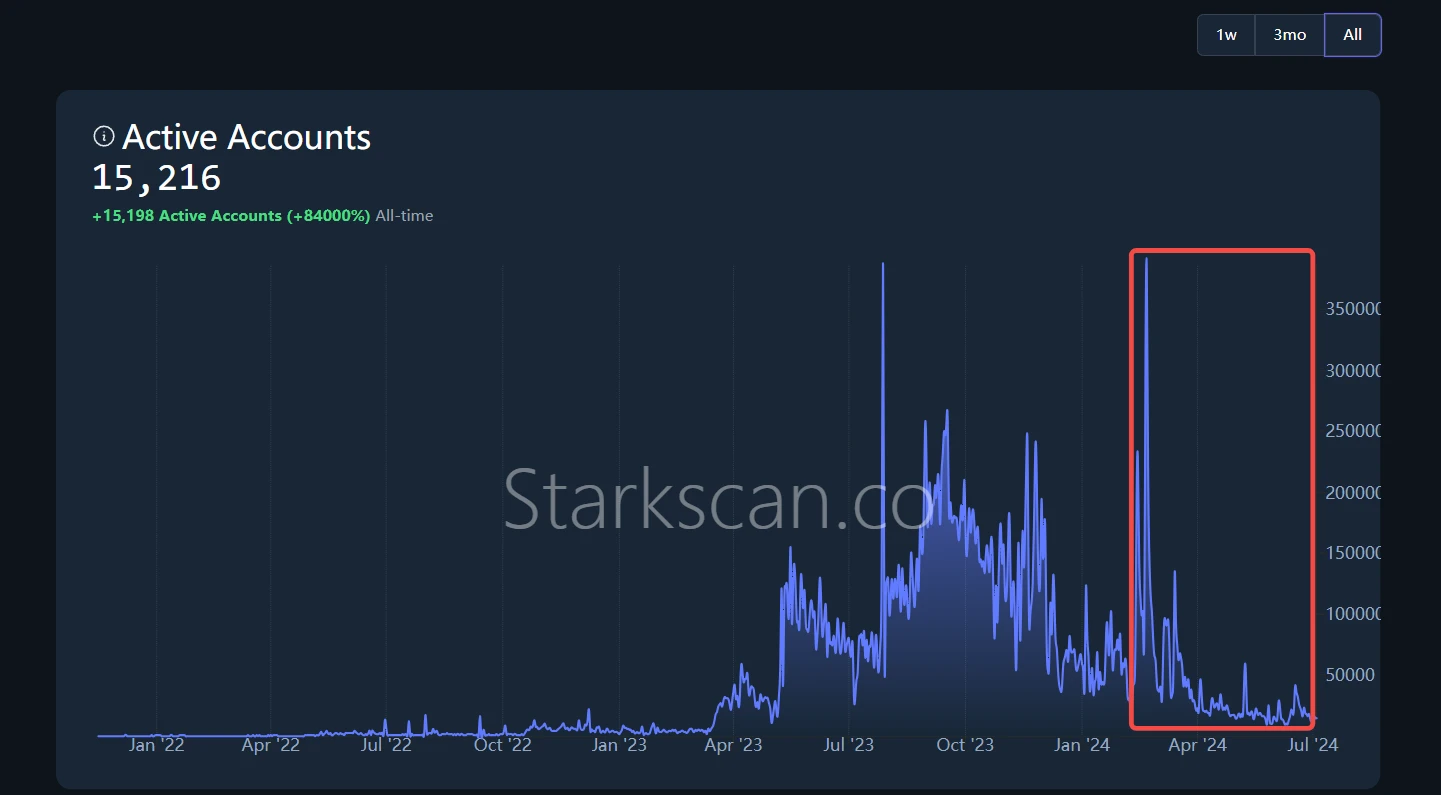
However, after most users claimed the airdrop, the number of daily active addresses also plummeted, until after June 20th, the number of daily active addresses had dropped to the level of March 2023, around 15,000 to 20,000.
From May 2023 to February 2024, the average number of daily active addresses on the Starknet network was about 100,000 before the airdrop was announced. Currently, after the end of the airdrop, the number of daily active addresses has decreased by about 80%.
TVL: U-denominated decreased after the airdrop, but the coin-denominated did not decrease
According to the data from Starknet's official browser starkscan, overall, the TVL of the Starknet network is still on the rise. Calculated in coin-denominated, the amount of ETH locked has been increasing. Even after the STRK airdrop, the TVL did not decrease much. The decline in TVL of STRK in April in the image was due to the drop in coin price, and the actual total amount of locked STRK did not change much.
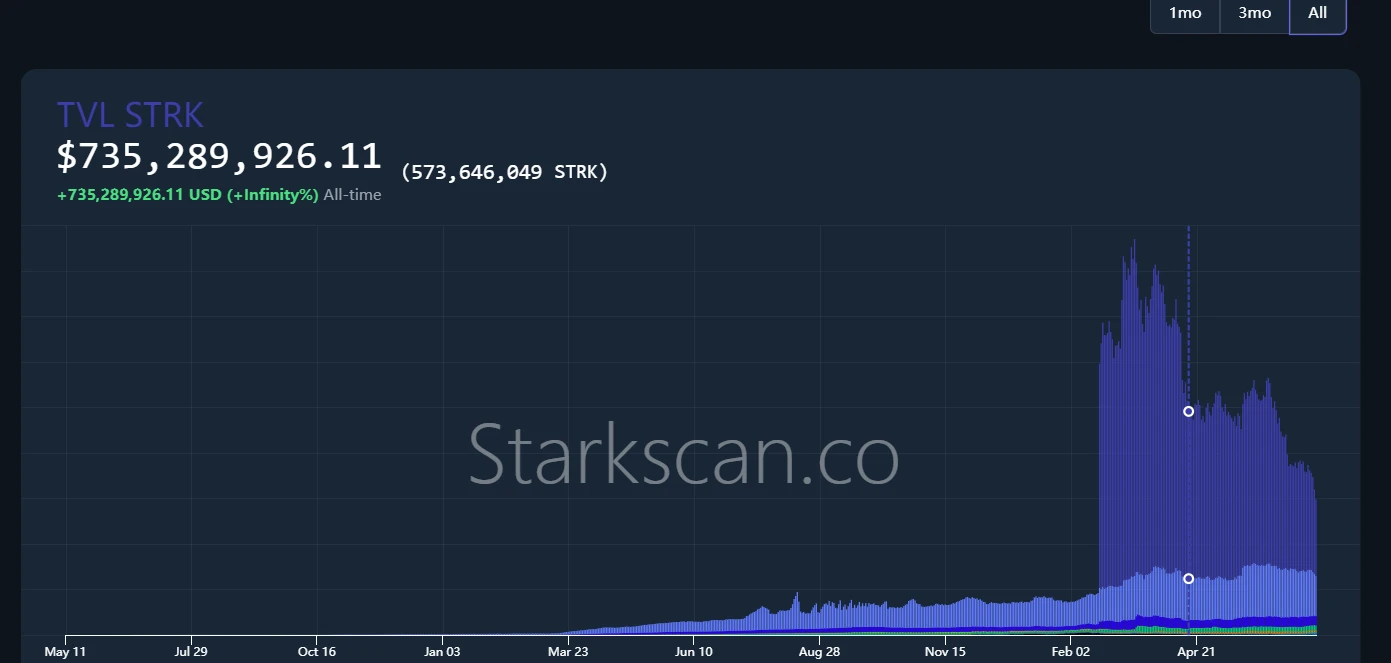
No significant change in daily trading volume, but the number of transactions decreased
According to Defillama's data, there was no significant change in the daily trading volume on the Starknet network before and after the airdrop, and the end of the airdrop did not affect the enthusiasm of users to trade on the Starknet network.
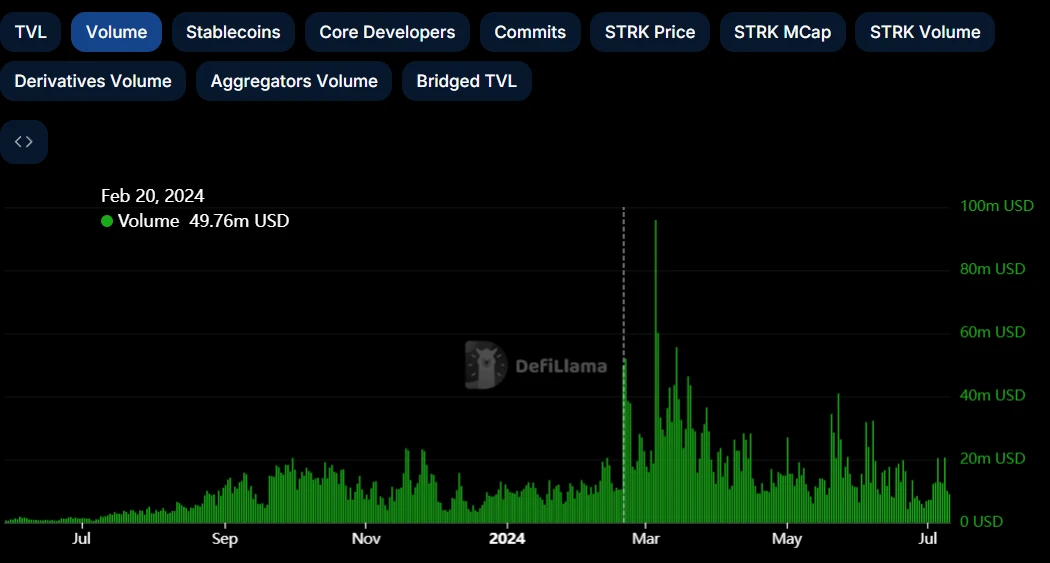
However, the daily number of transactions plummeted. According to Artemis's data, on the day of the airdrop on February 20th, the daily number of transactions on the Starknet network reached a new high, but overall, it showed a downward trend, far from the level before the airdrop.
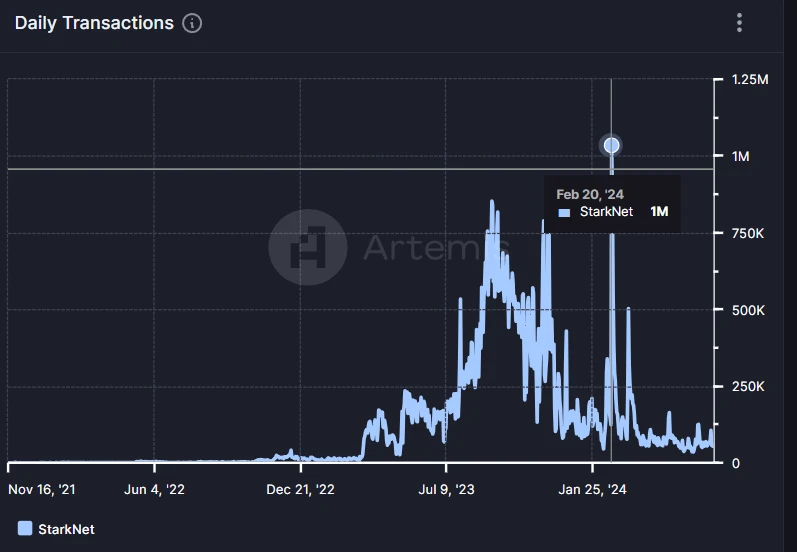
Conclusion
The above data overall reflects that due to the withdrawal of fake users and studios after the end of the airdrop, the number of active users and transaction frequency has decreased, but the overall network quality has not decreased significantly. The TVL and daily trading volume of the network did not differ much before and after the airdrop. At the same time, the overall decrease in the number of transactions has led to a decrease in network fees and income after the airdrop.
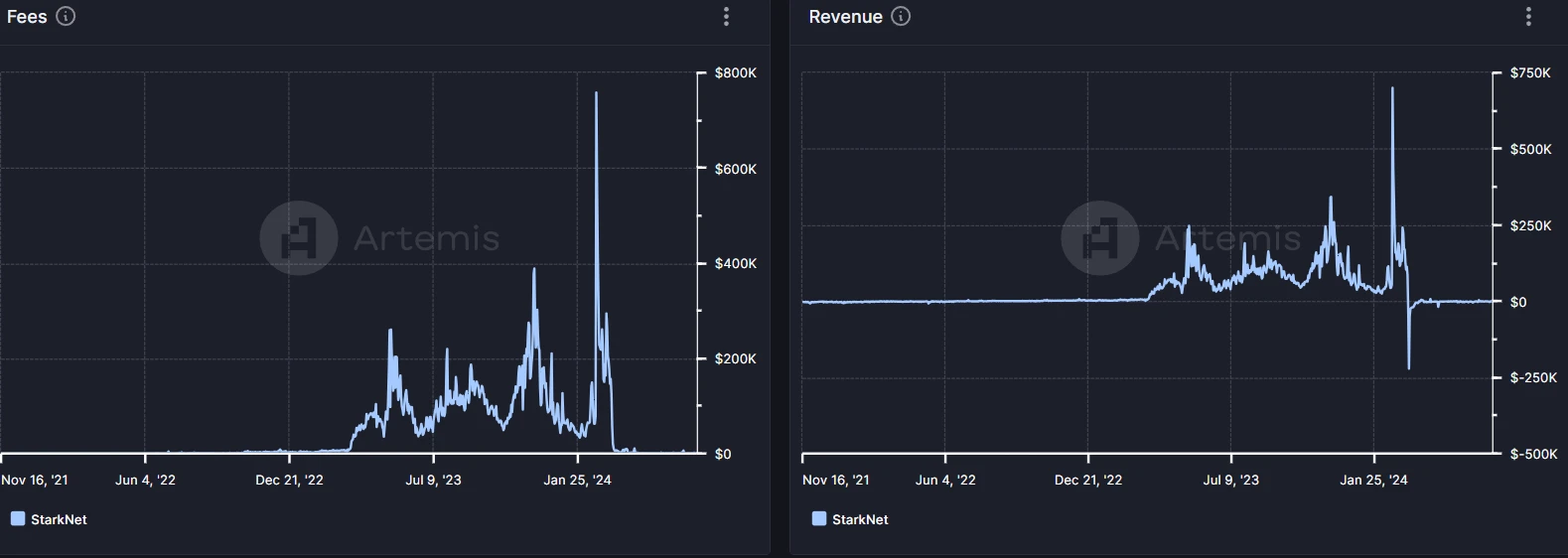
ZKsync: Highest proportion of real users, good network quality
The official token ZK of ZKsync was available for airdrop starting from June 17th.
The number of active addresses decreased by about 40% compared to before the airdrop
According to the Dune dashboard created by Matter Labs, the number of daily active addresses on the day of the airdrop of ZKsync reached a historical high. After most users claimed the airdrop, the number of daily active addresses decreased by about 70% compared to the day of the airdrop, but only decreased by about 40% compared to before the airdrop.
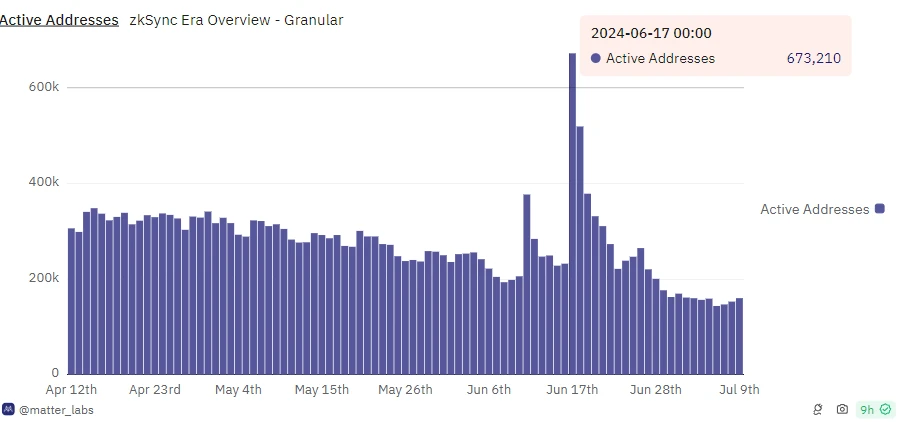
TVL: U-denominated decreased, but not significantly affected by the airdrop
According to Artemis's data, the TVL of the ZKsync Era network has been declining in U-denominated since March this year before the start of the airdrop, and continued to decline after the airdrop in June.
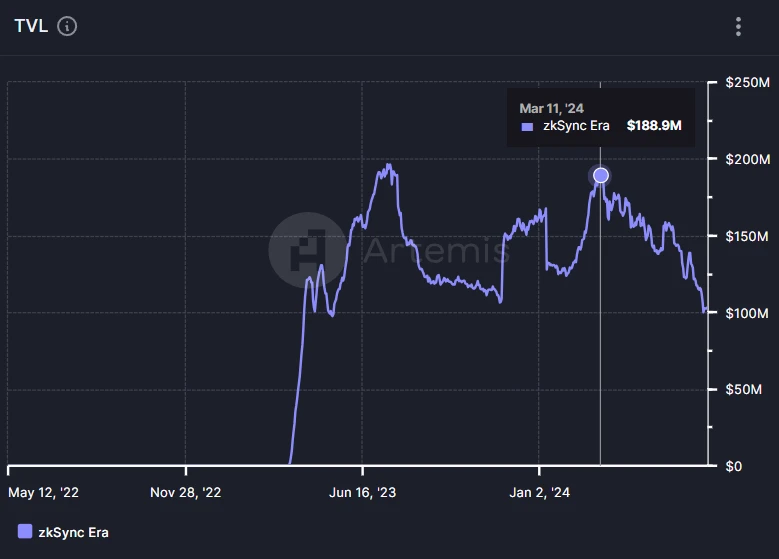
However, according to L2beat's data, the decline in TVL of the ZKsync Era network after the airdrop is not significant when calculated in coin-denominated. It can be seen that the decrease in TVL is not significantly affected by the airdrop, but may be more affected by other factors (such as the overall market trend, coin price, and ecosystem development).
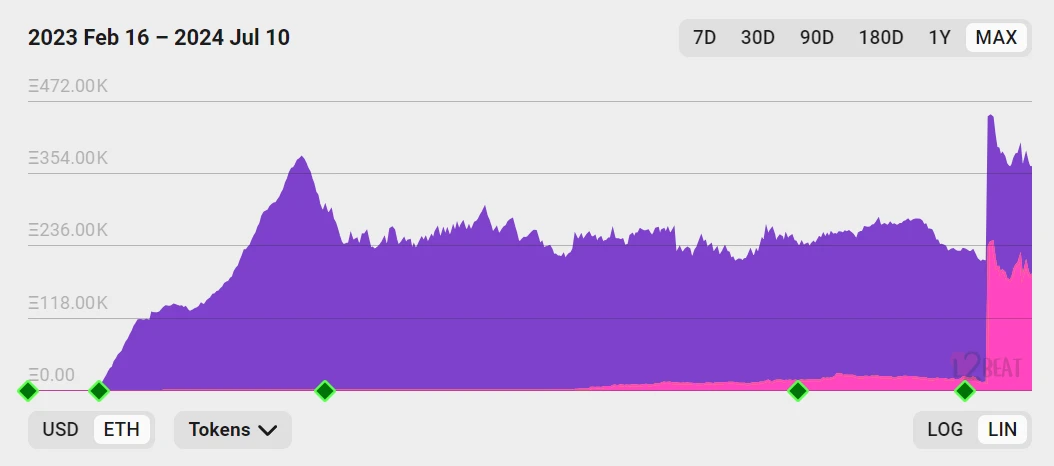
No significant change in daily trading volume before and after the airdrop
According to Defillama's data, due to the demand for claiming the airdrop, the trading volume of the ZKsync Era network reached a record high of $240 million on June 17th, 2024. However, after the airdrop was claimed, the daily trading volume quickly returned to the average level, without a significant decrease.
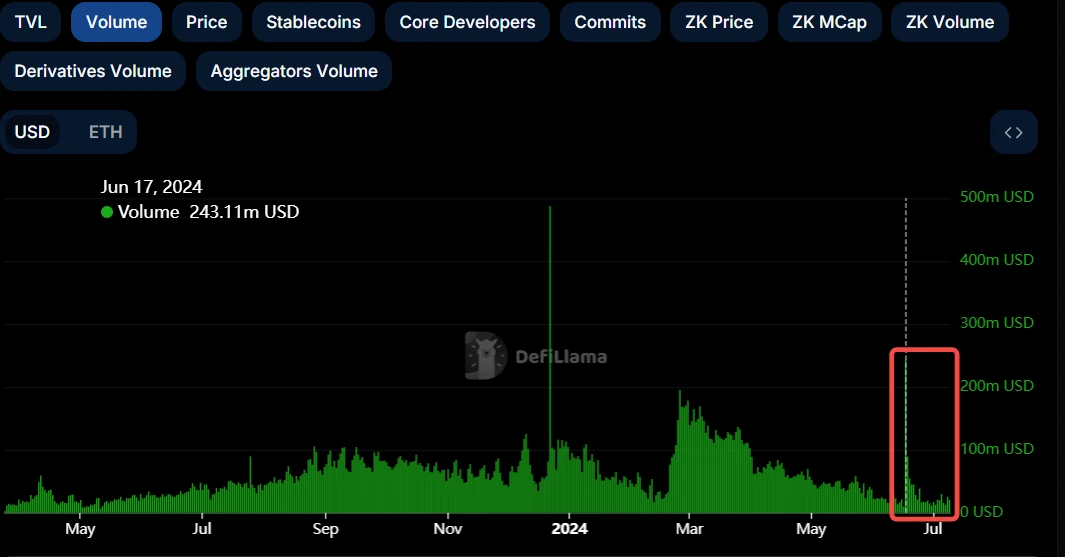
However, similar to the number of daily active addresses, the daily number of transactions on the ZKsync Era network reached a historical high of about 1.7 million transactions on the day of the airdrop on June 16th, and then decreased by about 50% compared to the average daily number of transactions before the airdrop.
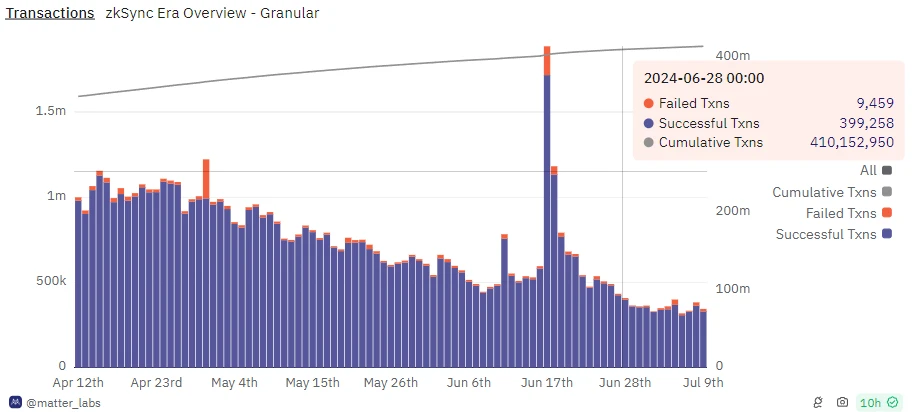
Conclusion
The above data overall reflects that the proportion of real users in the ZKsync Era network is relatively high, with a decrease in user and transaction frequency of only 40% to 50% before and after the airdrop, and minimal changes in other aspects of network quality due to the airdrop.
LayerZero: Largest user loss, drastic decline in network quality
LayerZero announced a snapshot in early May and officially opened the airdrop application on June 20th.
The number of daily active addresses decreased by about 85% compared to before the snapshot announcement
According to Dune data, after LayerZero announced the completion of the snapshot in early May, the number of on-chain active addresses plummeted. Before May 2nd, there were over 110,000 on-chain active addresses, but after May 2nd, it decreased by about 40%, and then gradually reached a new low, with a decrease of over 85% compared to before the snapshot announcement.
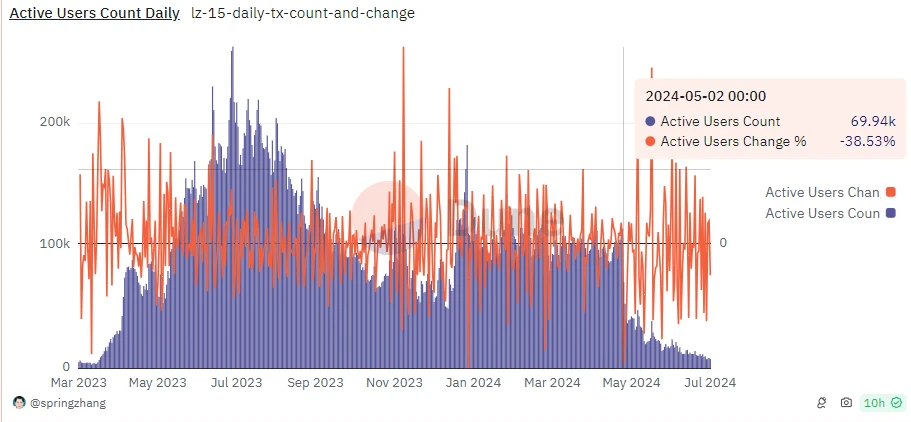
Cross-chain messages decreased by about 80% compared to before the airdrop
According to LayerZero's official browser layerzeroscan data, the total number of messages using LayerZero for cross-chain transactions also experienced a drastic decline after the official snapshot announcement. Except for a slight improvement on the day of the airdrop on June 20th, the average decrease was over 80% compared to before the airdrop, returning to the level of March 2023.
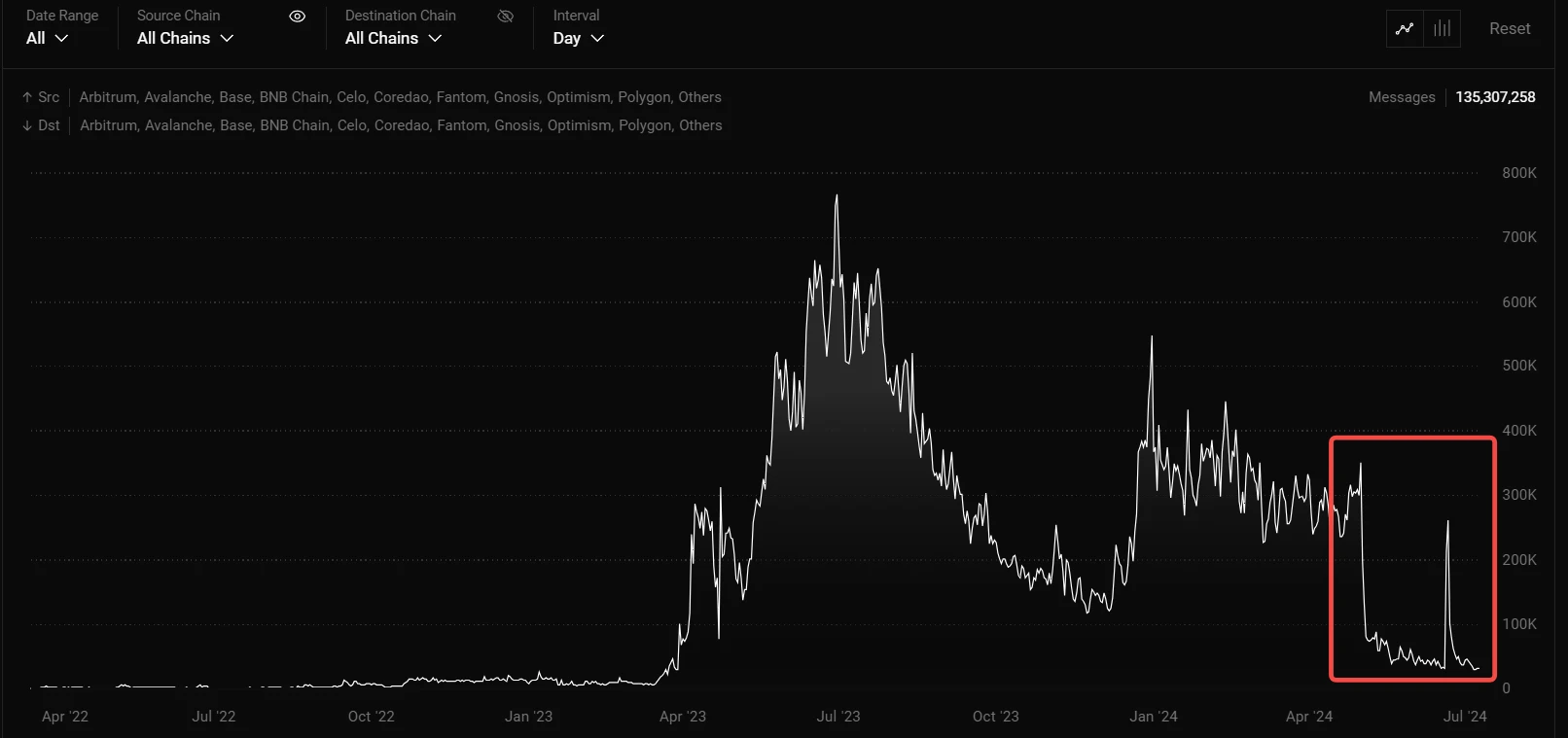
Cross-chain amount and daily transaction count decreased by over 90%
According to Dune data, the daily cross-chain funds using LayerZero experienced a drastic decline after the official snapshot announcement, averaging around $15 million per day. Compared to the peak period before the airdrop, it decreased by over 90%.

Similarly, the daily transaction count using LayerZero also began to decline after the snapshot announcement, decreasing by about 47% on the day the snapshot ended. After the airdrop, the daily transaction count averaged around 20,000, a decrease of over 90% compared to the previous average of 200,000 daily transactions.
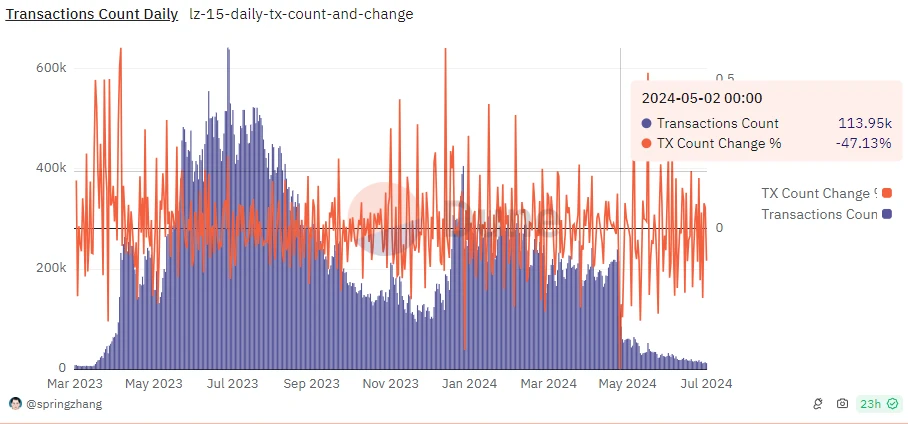
Conclusion
The above data reflects that the performance of the LayerZero network is not objective, with significant differences in data before and after the airdrop. Both the user base and network quality have decreased by about 90% compared to before the airdrop, proving that the real user demand for LayerZero is only 1/10 of what it was before the airdrop, after the withdrawal of fake users and studios.
Blast: Lack of user confidence, uncertain future development
Blast announced the airdrop one week after February 20th, and the official token BLAST's airdrop application started on June 26th.
Continuous decrease in daily active addresses
According to Artemis's data, the number of daily active addresses for Blast in June showed an overall upward trend, indicating an actual increase in user confidence in Blast. However, when the airdrop landed on June 26th, the number of daily active addresses plummeted, returning to the level of March within a few days, and this downward trend continues.
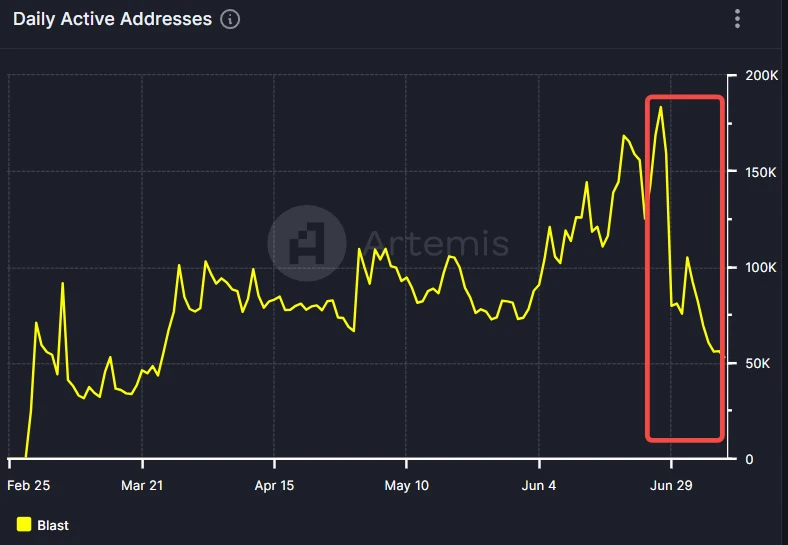
TVL started declining before the airdrop
According to Artemis's data, the TVL of the Blast network began to show a downward trend when the official announcement of the upcoming airdrop was made on June 20th, and the downward trend became more pronounced after the airdrop on June 26th, with funds withdrawing from Blast.
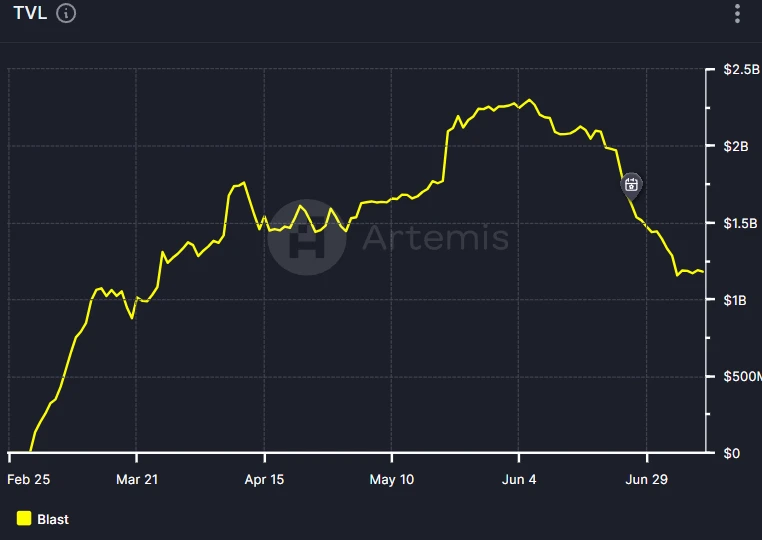
No significant change in daily trading volume, drastic decrease in daily transaction count
According to Defillama's data, the trading volume for the Blast network in June showed an upward trend, reaching a historical high on June 26th due to the airdrop, but quickly returned to the average level of June before the airdrop.
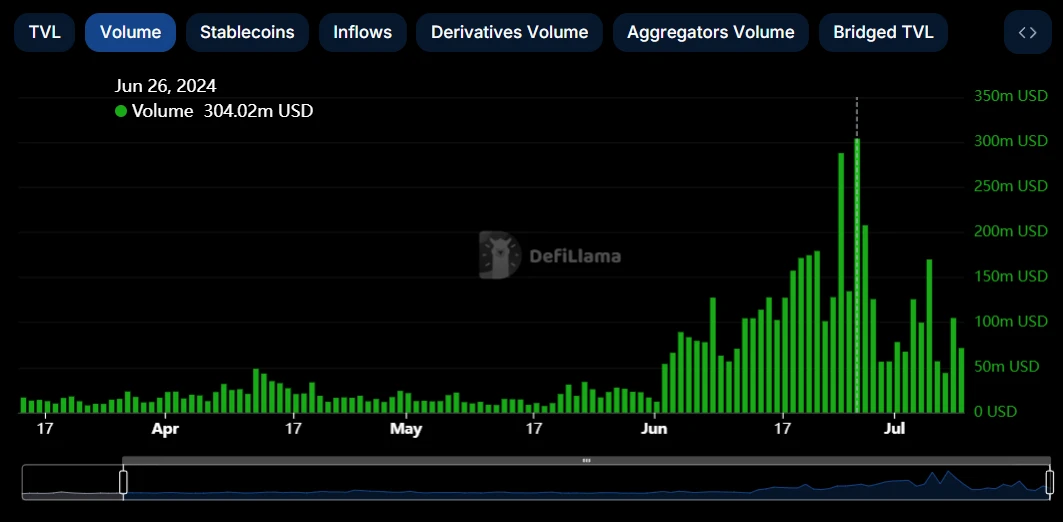
The daily transaction count, similar to the daily active addresses, began to decline after the official announcement of the airdrop on June 20th. There was a brief increase on July 2nd when the decentralized leveraged trading protocol Particle in the Blast ecosystem opened the airdrop to users, but overall, there is still a downward trend.
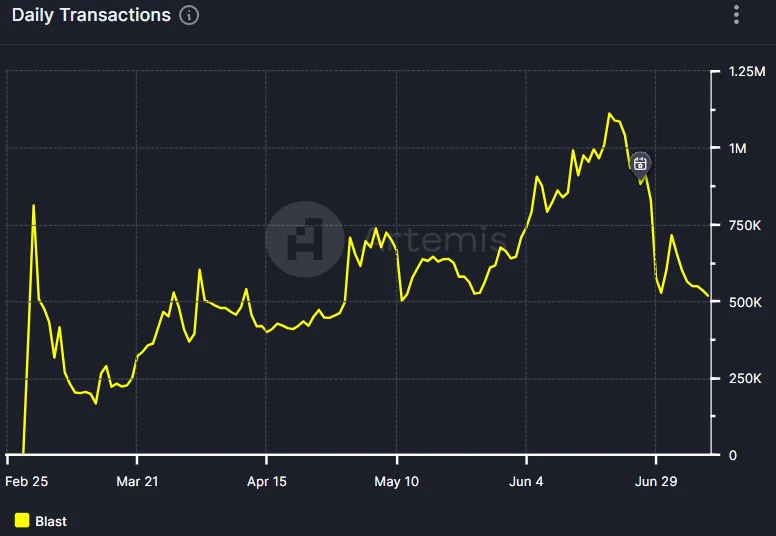
Conclusion
The above data reflects that although the first phase of the Blast airdrop has not ended for long, there is a clear lack of user confidence in Blast. Both users and funds show clear signs of withdrawal compared to before the airdrop. However, the trading volume also indicates that the network quality is currently in a relatively good state due to ecosystem development and new phase airdrop incentives.
Conclusion
In summary, it can be seen that before the airdrop, these 4 projects indeed had a significant amount of speculation in terms of user base and on-chain activity. However, with the withdrawal of fake users and studios after the airdrop, the real on-chain data is revealed, and all projects return to their true value, allowing us to objectively see who is swimming naked.
For the two Ethereum L2 projects (Starknet and ZKsync) that focus on technical narratives, after the airdrop, from the perspective of real user count and network quality, they are not as bad as imagined, and the TVL and trading volume did not decrease proportionally with the decrease in active addresses.
On the other hand, the cross-chain interoperability protocol LayerZero and the yield-based L2 Blast showed significant differences in data before and after the airdrop, especially LayerZero, where not only did the number of active addresses decrease significantly, but the daily cross-chain amount also experienced a drastic decline. This indirectly indicates that the true value of cross-chain protocols needs further evaluation after the airdrop bubble bursts.
Of course, the current data does not represent their performance. With the development of mainstream narratives, market changes, and progress in project roadmaps, the future market will choose truly valuable projects and eliminate those that rely on airdrop point strategies to gain temporary popularity.
After all, when the airdrop ends, only the real deal matters.
免责声明:本文章仅代表作者个人观点,不代表本平台的立场和观点。本文章仅供信息分享,不构成对任何人的任何投资建议。用户与作者之间的任何争议,与本平台无关。如网页中刊载的文章或图片涉及侵权,请提供相关的权利证明和身份证明发送邮件到support@aicoin.com,本平台相关工作人员将会进行核查。




